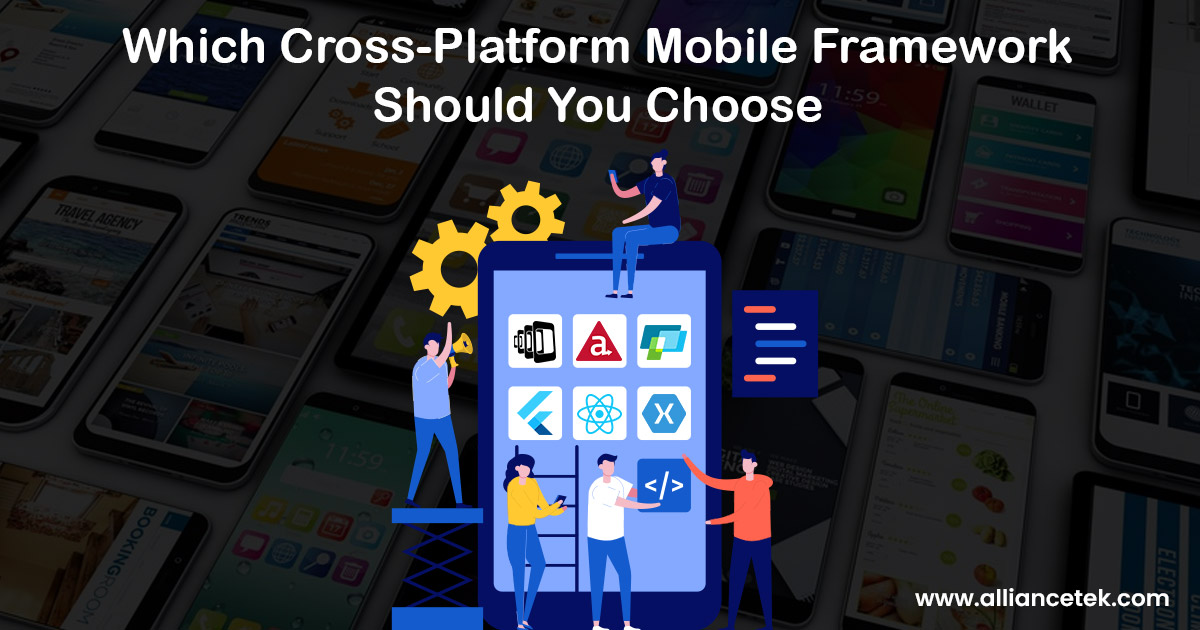With so many apps in the marketplace, app developers must be more agile than ever. The ability to deliver apps to multiple mobile platforms is important for reaching a wider audience, but each has its native language, UI/UX, developer tools, and environments. Developers often rely on cross-platform frameworks to develop an app that will run on multiple platforms and can be maintained easily.
However, there is an ever-increasing number of cross-platform mobile application development frameworks and many developers are unsure which is the best choice for their app.
Here, we will look at some of the top choices and assess the pros and cons so you can make an informed decision.

PhoneGap/Cordova
PhoneGap, an open-source mobile development framework, utilizes JavaScript, HTML5, and CSS3, bypassing the need for native language coding. It supports a wide range of platforms including iOS, Android, Blackberry, WebOS, Windows Mobile, and Bada. Adobe acquired PhoneGap in 2011, and its core was contributed to the open-source community as Cordova.
# Pros
- Cost-Effective: Being free and open-source, it allows developers to create apps without financial investment.
- Ease of Use: Utilizes common web languages (HTML, CSS, JavaScript), making it accessible to developers without the need to learn new languages.
- App Store Presence: Apps developed are indistinguishable from native apps in terms of installation and discoverability in app stores.
- Payment Integration: Simplifies the inclusion of payment transactions within apps.
# Cons
- Maintenance and Updates: Open-source nature means no guaranteed updates or completeness.
- Performance Issues: Known to struggle with graphically intensive applications, a non-issue in native development.
- Plugin Challenges: Finding necessary plugins can be difficult, sometimes requiring custom development.
- Limited Documentation: Information on usage and interface can be scarce.
Appcelerator Titanium
Appcelerator offers a cross-platform mobile development framework with an open-source SDK, supporting languages like Python, HTML5, Ruby, JavaScript, CSS3, and PHP. It distinguishes itself with a platform-independent JavaScript API that accesses native UI elements.
# Pros
- Unified UI: The Alloy framework ensures consistent UI across platforms without performance degradation.
- Rapid Development: Leverages JavaScript for code normalization across platforms, enhancing code reusability and speeding up development.
- Community and Support: Offers Backend-as-a-Service (BaaS), app analytics, a marketplace for third-party components, and has a growing developer community.
# Cons
- Complexity: Some find the framework increasingly complex and inflexible.
- Stability Issues: Users have reported bugs and errors, diminishing its initial appeal.
- Build Environment: Requires a controlled build environment, particularly challenging when targeting multiple platforms.
jQuery Mobile
Overview: jQuery Mobile, renowned for its wide device compatibility, employs HTML5 & CSS3 for UI design, minimizing the need for extensive scripting. It's celebrated for its ease of use and cross-platform capabilities.
# Pros
- User-Friendly Interface: Offers a rich UI that is straightforward to use.
- Cross-Platform Efficiency: Reduces developer workload by handling cross-platform and device compatibility issues.
- Theme Customization: ThemeRoller allows for personalized theme creation.
- Simplified Development: Leverages JavaScript for easier app development.
# Cons
- Design Limitations: Best suited for simple designs; struggles with more customized UI requirements.
- Integration Issues: Potential challenges with AJAX and postbacks, especially in .NET environments.
- Framework Limitations: While powerful, it may not suit all types of mobile application development projects.
Flutter
Flutter, developed by Google, is a relatively new entrant to the cross-platform development scene but has quickly gained popularity due to its unique approach and powerful features. It uses the Dart programming language and offers a rich set of pre-designed widgets that allow for the creation of visually attractive and highly responsive user interfaces.
# Pros
- Hot Reload: Flutter's hot reload feature significantly speeds up the development process by allowing developers to see the results of their changes in real-time without restarting the app.
- Single Codebase: Developers can write a single codebase for both iOS and Android platforms, which simplifies the development process and reduces the time to market.
- Performance: Flutter compiles native code, which helps achieve performance that is on par with native applications, especially in terms of UI smoothness and startup times.
# Cons
- Learning Curve: For developers not familiar with Dart or Flutter's approach to UI design, there can be a learning curve.
- Package Availability: While the ecosystem is rapidly growing, it may not yet have the same breadth of third-party packages and libraries available for more established frameworks.
React Native
React Native, created by Facebook, allows developers to build mobile apps using JavaScript and React. Its approach to cross-platform development involves writing UI components in JavaScript, which then interact with native code for high performance.
# Pros
- Native Performance: React Native components are rendered to native platform UI, ensuring that the app feels like a native app in terms of performance and user experience.
- Large Community: With the backing of Facebook and a large developer community, React Native has a vast ecosystem of libraries, tools, and frameworks, making it easier to find resources and support.
- Code Reusability: Developers can reuse code across iOS, Android, and even web applications, which accelerates development and reduces costs.
# Cons
- Native Code Requirements: For some features, developers may need to write native code or use third-party libraries, which can complicate the development process.
- Upgrades and Maintenance: React Native's rapid development cycle can lead to challenges in keeping apps up to date with the latest versions of the framework.
Xamarin
Xamarin, a Microsoft-owned framework, enables developers to use .NET and C# to create apps for Android, iOS, and Windows. It offers a blend of native performance and the ability to share code across platforms.
# Pros
- Native Performance: Xamarin apps are compiled into native code, which can lead to superior performance compared to other cross-platform approaches.
- .NET Ecosystem: Developers can leverage the extensive .NET ecosystem, including various libraries, tools, and frameworks, for their mobile applications.
- Visual Studio Integration: Xamarin is tightly integrated with Visual Studio, providing a robust development environment with powerful debugging and testing tools.
# Cons
- Larger App Size: Xamarin apps can have a larger file size compared to native apps, which might be a concern for some applications.
- Platform-Specific Code: While Xamarin allows for a significant amount of code reuse, developers may still need to write platform-specific code for certain features, adding complexity to the development process.
When selecting a cross-platform mobile development framework, it's crucial to consider the specific needs of your project, including performance requirements, UI complexity, and the availability of development resources. Each framework offers a unique set of advantages and challenges, and the best choice depends on the goals and constraints of your mobile app project.
What cross-platform development tools have you used? What were some obstacles you encountered with them? Let us know in the comments below.
Call us at 484-892-5713 or Contact Us today to know more details about the which Cross-Platform Mobile Framework should you choose?.


